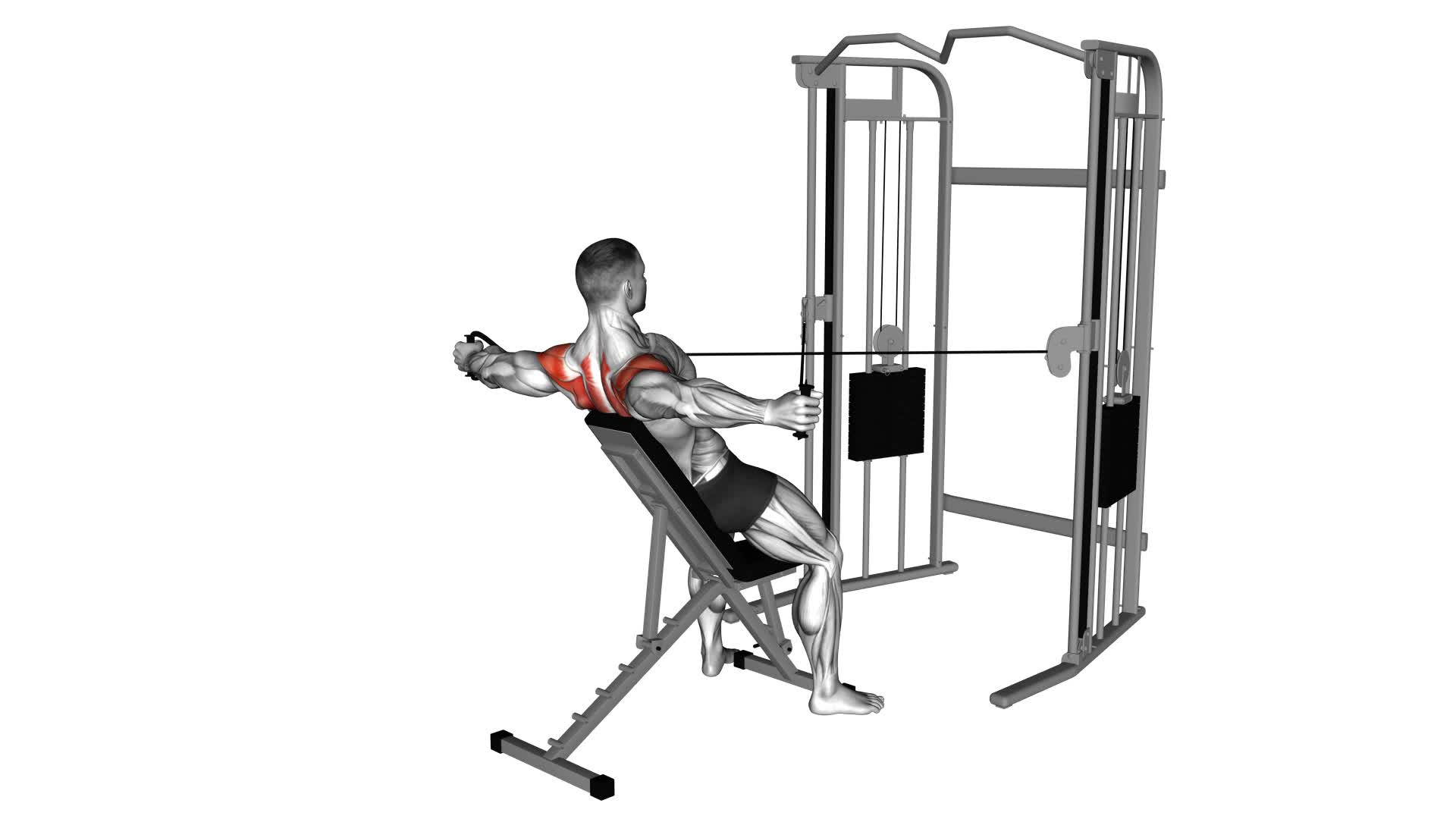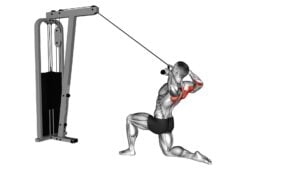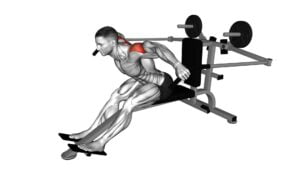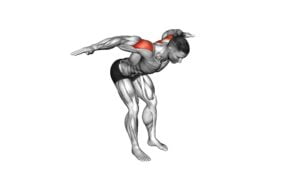Cable Incline Rear Delt Fly With Back Support (Male) – Video Exercise Guide & Tips

Incline your back and engage your rear deltoids with the cable incline rear delt fly. This exercise, specifically designed for males, targets the muscles in your upper back and shoulders.
Watch This Exercise Video
With the help of back support and a cable machine, you'll learn the proper set-up, correct form, and variations to maximize effectiveness.
Follow our video exercise guide and tips to ensure you're getting the most out of this challenging workout.
Let's get started!
Key Takeaways
- Cable incline rear delt fly targets the rear deltoid muscles, improving posture and shoulder stability.
- Proper form and technique, including maintaining a neutral spine and avoiding excessive momentum, are crucial for maximizing the effectiveness of the exercise.
- There are various variations and modifications of the cable incline rear delt fly, allowing for customization based on individual needs and goals.
- Safety precautions should be taken, such as starting with a light weight to warm up, using a spotter if needed, and stopping if any pain or discomfort is experienced.
Equipment Needed
To perform the Cable Incline Rear Delt Fly with Back Support (Male) exercise, you'll need the following equipment:
- A cable machine with adjustable pulleys to properly adjust the resistance for the exercise.
- A bench with back support that can be set at an incline to provide stability and support during the exercise.
Now let's talk about the benefits of the Cable Incline Rear Delt Fly. This exercise primarily targets the rear deltoid muscles, located at the back of your shoulders. By working these muscles, you can improve your posture, shoulder stability, and overall upper body strength. It also helps prevent imbalances between the front and back muscles of the shoulder.
To maximize the benefits of this exercise, it's important to avoid some common mistakes. Firstly, avoid using too much weight, as this can lead to improper form and potential injury. Secondly, maintain proper posture throughout the movement, keeping your back straight and shoulders relaxed. Lastly, avoid using excessive momentum to perform the exercise, as this can take away from the targeted muscle engagement.
Now that you know the equipment needed and the benefits of the Cable Incline Rear Delt Fly, let's move on to the proper set-up for this exercise.
Proper Set-up
To properly set up for the Cable Incline Rear Delt Fly with Back Support exercise, position yourself on the bench with the back support adjusted to an incline, ensuring stability and support for your upper body. Adjust the back support of the bench to a comfortable incline that allows you to maintain proper form throughout the exercise. Sit on the bench with your feet flat on the ground, shoulder-width apart. Hold the cable handles with an overhand grip, palms facing each other, and bring them close to your chest. Lean forward slightly, maintaining a neutral spine, and engage your core muscles for stability.
This exercise primarily targets the rear deltoids, but it also engages the upper back muscles and trapezius. Proper set-up is crucial to ensure effective muscle activation and to prevent common mistakes such as using excessive momentum or improper form. By positioning yourself correctly and maintaining stability, you can maximize the benefits of the Cable Incline Rear Delt Fly with Back Support exercise.
Correct Form and Technique
Once you have properly set up for the Cable Incline Rear Delt Fly with Back Support exercise, it's important to focus on maintaining correct form and technique. To ensure you get the most out of this exercise and avoid injury, it's crucial to be aware of some common mistakes and pay attention to proper muscle activation.
One common mistake is using too much weight. It's essential to choose a weight that allows you to perform the exercise with control and proper form. Using excessive weight can lead to improper movement patterns and decrease the effectiveness of the exercise.
Another mistake is failing to maintain a neutral spine. It's important to keep your back flat against the support pad throughout the movement. This helps to engage the targeted muscles and protect your lower back from unnecessary strain.
Proper muscle activation is key to maximizing the benefits of the Cable Incline Rear Delt Fly. To activate your rear deltoids effectively, focus on squeezing your shoulder blades together as you pull the handles towards your chest. This will ensure that you're engaging the correct muscles and performing the exercise correctly.
Variations and Modifications
Continue maximizing the benefits of the Cable Incline Rear Delt Fly with Back Support exercise by exploring various variations and modifications. By incorporating alternative exercises and avoiding common mistakes, you can enhance your workout routine and target your rear deltoids more effectively.
Here are some variations and modifications to consider:
- Single-arm Cable Incline Rear Delt Fly: Perform the exercise with one arm at a time to increase the focus on each rear deltoid individually. This can help improve muscle imbalances and overall symmetry.
- Resistance Band Rear Delt Fly: Substitute the cable machine with a resistance band anchored at waist height. This variation allows for a greater range of motion and can be done anywhere, making it a convenient option for home workouts.
- Seated Rear Delt Fly: Sit on a bench or chair and perform the exercise while seated. This modification reduces the involvement of your lower body and forces your rear deltoids to work harder.
- Dumbbell Rear Delt Fly: Instead of using a cable machine, use dumbbells to perform the exercise. This variation provides a slightly different stimulus to your rear deltoids and can help improve stability.
Remember to focus on maintaining proper form and technique during these variations and modifications. Avoid swinging your body or using momentum to lift the weight, as this can reduce the effectiveness of the exercise and increase the risk of injury.
Experiment with these variations to find the ones that best suit your needs and goals.
Tips for Maximum Effectiveness
To maximize the effectiveness of the Cable Incline Rear Delt Fly with Back Support exercise, focus on maintaining proper form and technique. Ensure that you engage your rear deltoids and avoid any swinging or momentum. One of the common mistakes people make with this exercise is using too much weight. It's important to start with a weight that allows you to perform the exercise with control and good form. Using too heavy of a weight can lead to using momentum and sacrificing the engagement of the target muscles.
Another mistake to avoid is rounding your back during the exercise. It's crucial to keep your back straight and supported by the bench or back support to prevent any strain or injury. Additionally, make sure to keep your core engaged throughout the movement to maintain stability.
To get the most out of this exercise, focus on the mind-muscle connection. Visualize your rear deltoids contracting and squeezing as you perform the movement. This will help you to better engage the targeted muscles and maximize effectiveness.
Remember, it's always better to start with lighter weight and perfect your form before increasing the resistance. Gradually increase the weight as you become more comfortable and confident in your technique.
Frequently Asked Questions
How Many Repetitions Should I Do for the Cable Incline Rear Delt Fly Exercise?
To determine the right repetition range for the cable incline rear delt fly exercise, it's important to consider your fitness level and goals.
Generally, a good starting point is to aim for 8-12 repetitions per set. This allows for proper form and muscle engagement without sacrificing intensity.
As you become more comfortable and stronger, you can gradually increase the number of repetitions.
Can I Do This Exercise if I Have a Shoulder Injury?
If you have a shoulder injury, it's important to focus on rehabilitation exercises specifically designed for shoulder injuries.
It's best to avoid exercises that could aggravate your injury. Instead, consult with a healthcare professional or a physical therapist who can provide you with alternative exercises for shoulder injury recovery.
They can guide you on exercises that will help strengthen and stabilize your shoulder without causing further harm.
Should I Use a Specific Type of Cable Machine for This Exercise?
When selecting a cable machine for this exercise, it's important to choose one that allows for proper range of motion and provides enough resistance. Look for a machine with adjustable pulleys and a weight stack that suits your strength level.
However, if you don't have access to a cable machine, there are alternative exercises that target the rear deltoids such as bent-over dumbbell flyes or resistance band pull-aparts.
Can I Do the Cable Incline Rear Delt Fly Exercise Without Using Back Support?
Yes, you can do the cable incline rear delt fly exercise without using back support. However, it's recommended to use back support as it provides stability and helps maintain proper form throughout the exercise.
Without back support, you may experience difficulty in targeting the rear deltoid muscles effectively. Using back support also reduces the strain on your lower back and allows you to focus solely on engaging the targeted muscles.
How Long Should I Rest Between Sets for This Exercise?
To maximize the benefits of the cable incline rear delt fly exercise, it's important to rest between sets. Resting periods allow your muscles to recover and prepare for the next set. The optimal resting period for this exercise is typically around 60-90 seconds. However, it's important to listen to your body and adjust the resting period accordingly.
Additionally, maintaining proper form throughout the exercise is crucial to prevent injuries and ensure effective results.
Conclusion
In conclusion, the cable incline rear delt fly with back support is a highly effective exercise for targeting the rear deltoid muscles. By utilizing proper form and technique, along with variations and modifications, you can maximize the effectiveness of this exercise.
Remember to adjust the equipment and set up properly before performing the exercise. Incorporating this exercise into your workout routine can help strengthen and tone your rear deltoids, improving your overall upper body strength and posture.

Author
Years ago, the spark of my life’s passion ignited in my mind the moment I stepped into the local gym for the first time. The inaugural bead of perspiration, the initial endeavor, the very first surge of endorphins, and a sense of pride that washed over me post-workout marked the beginning of my deep-seated interest in strength sports, fitness, and sports nutrition. This very curiosity blossomed rapidly into a profound fascination, propelling me to earn a Master’s degree in Physical Education from the Academy of Physical Education in Krakow, followed by a Sports Manager diploma from the Jagiellonian University. My journey of growth led me to gain more specialized qualifications, such as being a certified personal trainer with a focus on sports dietetics, a lifeguard, and an instructor for wellness and corrective gymnastics. Theoretical knowledge paired seamlessly with practical experience, reinforcing my belief that the transformation of individuals under my guidance was also a reflection of my personal growth. This belief holds true even today. Each day, I strive to push the boundaries and explore new realms. These realms gently elevate me to greater heights. The unique combination of passion for my field and the continuous quest for growth fuels my drive to break new ground.







